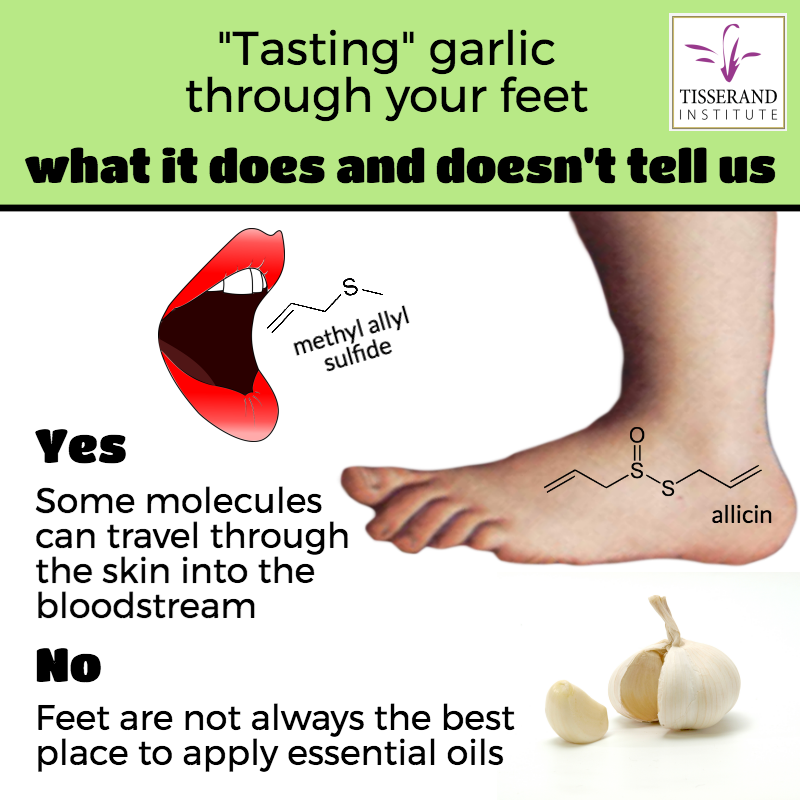How is the “taste garlic with your feet” experiment relevant to aromatherapy?
Did you know you can taste garlic through your feet? Try it. Just rub some fresh garlic on the soles of your feet and wait a while. You should be able to taste it in your mouth and smell it in your breath in 15 minutes or less. This video shows how it works, in theory and practice: https://youtu.be/qiM3kZWPZtA Now, that is a cool experiment, perhaps even a party trick, but how is it relevant to aromatherapy?
First of all let’s look at the science behind garlic “feet tasting”. When you cut or crush garlic, the mechanical action acts as a catalyst, bringing aliin into contact with an enzyme, aliinase, which reacts with it, forming a new compound, allicin. Allicin, together with some other compounds, then penetrates through the skin and gets into the bloodstream. Just like any other chemical that enters our body, it is then metabolized, mainly into methyl allyl sulfide, diallyl sulfide and diallyl disulfide, three of the compounds responsible for the pungency of garlic and onions. These are then partially excreted through our lungs, and pulmonary excretion of sulfur compounds is the reason for “garlic breath”.
To put it simply, this experiment is a neat way of proving that small, volatile molecules can penetrate our skin, and get into the bloodstream – without having to do any blood tests! This definitely is relevant to the practice of aromatherapy, for both efficacy and safety reasons.
And garlic is perfect for this experiment – we smell it on the breath so readily because sulfur compounds can be detected at lower concentrations than almost any other volatile compound – in low parts per billion in the air.
The foot and garlic experiment shows us that garlic compounds can be absorbed through the skin of your feet, and creates a hypothesis that other molecules can also enter the body in the same way – through the skin. This doesn’t tell us that all volatile molecules will be absorbed equally – that’s quite another story. So what we are NOT seeing is evidence that significant amounts of any volatile compound are in the bloodstream, and we know that transdermal absorption does not achieve this (from tests that involved blood analysis).
Now, does this prove that the feet are the best place to apply essential oils? The simple answer is no. You would get the same effect if you rubbed garlic anywhere else on your body. If you choose a particularly thin-skinned area, such as your abdomen, you might get a higher level of absorption. The reason being that parts of our feet have the thickest layer of corneocytes – the outer layer of dried and flattened skin cells, and these present more of a barrier.
In treatment with essential oils, the way we apply them varies with the ailment we are dealing with https://tisserandinstitute.org/learn-more/essential-oil-applications/ Concerns about how much essential oil is absorbed through your skin and enter your bloodstream (bioavailability), are pertinent to treating internal issues, and for assessing internal toxicity. And if you want higher bioavailability, there are certainly better ways to achieve this. There’s nothing wrong with applying oils to your feet, and some will absolutely be absorbed, but it’s not always an ideal choice.
If you want to taste garlic, eating it is clearly the simplest route. In the same way, if you want to enjoy the benefits of essential oils, putting them on your feet may not be the most efficient thing to do – unless you’re treating a foot problem.


An an aromatherapist I have given some thought over the years to this idea of essential oils on feet wondering why this idea has been so prevalent in aromatherapy and if there is any truth in it. So thank you I really enjoyed this article. Here are my ideas that have come before and after reading it. Maybe the idea of traditionally putting essential oils on the feet for treatment is precisely because of the corneocytes. This layer reduces the potential for dermal irritation with neat essential oils such as tea tree or crushed garlic, unlike sensitive thin skinned stomach or face. Also perhaps the fact that feet can be covered easily to stop the essential oils evaporating and that the feet are often moist within socks creates an improved permeability to improve medium term absorption. The thickness of the outer dried skin could also act as a reservoir to store the essential oils (like a compress), allowing longer term absorption. So perhaps application to the feet is better for conditions that need mid and longer term treatment rather than a fast acting remedy. Feet also have reflex points and application with massage to these points with essential oils however arbitrarily could increase the potential as well.
I can’t find anywhere how the Allicin penetrates the skin. Is it diffusion? Is it the same thing how you can absorb other oils except to a fuRther extent?
Allicin has a low molecular weight (162.3) and a LogP of 1.3, so slightly oil-soluble. Such molecules penetrate the skin by the “intercellular” route – through the lipid matrix of the stratum corneum, and the co-presence of more lipid molecules in garlic, such as diallyl disulfide, facilitate this.